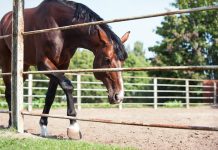
Lameness, unfortunately, is a common issue in our horses and ponies. Strong and fast but surprisingly fragile, our equine athletes have an astonishing natural physical ability that we are able to exploit for equestrian sports – but that can also leave them vulnerable to injuries as well as wear and tear.
In the case of lameness, your first port of call is a thorough veterinary work-up, to try establish the cause – there is no point trying to treat the wrong thing. Of course, horses can’t tell us exactly where it hurts – but they do give us clues.
Hoof and foot issues are by far the most common cause of lameness in horses, but another major cause is joint problems. These can range from mild to very severe, and from acute to chronic issues.
Unsurprisingly, this means there are a lot of different treatment options – having the joint injected by your vet is one such option, and this article will discuss some of the pros and cons of this treatment.
So, what are some of the most common reasons for a horse to have a joint or several joints injected? What are their joints being injected with? What does the medication do? And what are the potential risks and benefits?
First, we need to understand what a joint is.
A bit of anatomy
A joint is where two or more bones meet. It is a structure which often allows movement (some joints a lot more than others) and provides shock absorption. Not all joints are the same – a horse has three types of joints: synovial, fibrous and cartilaginous.
Fibrous joints are joints that don’t allow movement, such as those between the bones of the head. If you have ever seen a horse skull you will have noticed the lines on it, these are fibrous joints of the bones of the skull.
Cartilaginous joints are where the bones are joined together by cartilage. A little bit of movement occurs in these joints; one example is the discs that connect vertebrae in the spine.
Synovial joints are what we usually think of when we talk about joints. These are the ones that allow the most movement. There are different shapes and sizes and numbers of bones involved in various synovial joints but the anatomy them all includes four things:
- Two or more bones each covered with a thin layer of articular cartilage. The cartilage is very important and can be damaged by inflammation.
- A cavity that is filled with special joint fluid, known as synovial fluid.
- A fibrous joint capsule which surrounds the joint, supporting it and keeping all the fluid in place.
- The inner lining of the joint, an active layer known as the synovial membrane, which produces the synovial fluid which is very important for the health of the joint.
The joint is then usually further supported by stabilising ligaments around the joint which help prevent too much movement or even dislocation.
Joint problems
Joint problems can involve any of these structures. There can be stretching and tearing of the surrounding ligaments, inflammation of the synovial membrane (synovitis) or the capsule, damage to or defects of the articular cartilage or degenerative changes of the bone itself – or a combination of all of these. Any inflammation in a joint causes the release of enzymes and other substances, which cause damage to the important joint structures and their ability to perform their function is reduced. More inflammation then leads to more damage. The joint can repair itself to some degree, but if the inflammation and damage is severe it can overwhelm the repair process.
Signs and symptoms
- There is likely to be lameness (if several joints are affected on different legs this can be more difficult to see).
- There is usually swelling of the joint as more joint fluid is produced. Heat may be felt.
- A horse may not like tight flexion of the joint.
- A more definite sign that the pain is coming from the joint is that the lameness improves when local anaesthetic is injected.
- Sometimes changes can be seen by your veterinarian on either ultrasound (ligaments and joint capsule) or x-rays (changes in the bone). An MRI or CT scan will also show up changes. Early changes will not show up particularly on x-ray, as there has been no damage to the bone (which is a good thing) so using local anaesthetic to determine where the pain is coming from is very important.
The aim of a joint injection

The overall aims are to reduce the inflammation (and pain), prevent further damage, to help the joint repair itself and return it to functioning normally again.
There are two broad divisions of joint injections; steroids and non-steroids.
Steroid joint injections have been used for quite a long time, in both horses and humans. The correct term is corticosteroids. Corticosteroids are produced naturally by the body and have many functions. The corticosteroids that are used to inject joints have been developed to have increased anti-inflammatory effects and have less of the other functions of naturally-occurring steroids. They are strong anti-inflammatories and by injecting directly into the joint, only a small amount needs to be used, which reduces the risk of side effects. Steroid injections are very effective in taking away pain and discomfort from a joint which is why they are used frequently for both horse and human joints.
The steroid itself is not too costly; however, the process of doing the injection is quite complex as I will explain – there are a few important steps to go through, and it is a skilled procedure.
There are different types of steroids that may be used ,depending on the joint and how bad the problem is. It was initially thought that repeated injections of steroids may lead to worsening of the actual damage of the joint long-term, but this has not been shown to always be true. Studies have shown that some types of steroids may be less damaging than others, and may even be beneficial. More studies are ongoing. The type of steroid used, the concentration and how often a joint is injected can all be modified to increase the benefit and reduce the risk.
Sometimes steroids are combined with other medications. Hyaluronic acid (HA) is one that may be used; it is a naturally-occurring substance found in high concentration in joints, and injecting it may help prevent more damage to the cartilage layer.
One other point to make is that there is a competition/race withholding time after steroids are injected – although ideally the horse will be rested for a certain time afterwards anyway, depending on the condition.
Alternatives to steroids
In the last 10 to 20 years there have been some huge developments in the understanding of what goes on in an inflamed joint, and what we can do about it. There is still a lot more work to be done and there are cross-overs with research into human joint problems. It is an active area of research, which is good for everyone. Some of the products that have been developed to help with reducing joint inflammation and aiding repair are: IRAP, PRP, Pro-Stride and Arthramid, and there are others too. We will look at each of these in turn.
IRAP
IRAP is made from the horse’s own blood which is collected, then incubated overnight in a special syringe containing treated glass beads. This increases the amount of a naturally occurring anti-inflammatory protein (Interleukin 1 Receptor Antagonist Protein). The syringe is then spun down and separated into individual doses ready for injection into a joint. A course of treatments is often recommended.
PRP
PRP stands for platelet rich plasma and again is a product made from a horse’s own blood. This time the preparation time is quicker and increases the concentration of platelets in the dose to be injected. Platelets are, of course, naturally found in blood and usually involved in clotting and preventing bleeding but they also release substances that help with repair after tissue injury. Injecting into joints is to help stimulate repair of damaged tissue.
Pro Stride
This is another development to produce something from the horse’s own blood; almost a combination of IRAP and PRP. It does not need overnight incubation so the amount of IRAP is less than if just IRAP is produced alone. Pro Stride is designed to be anti-inflammatory and pro-repair.
Arthramid (2.5% cross-linked polyacrylamide hydrogel)
Arthramid is in a different category – it is a gel-type product that has been used for many years in human plastic surgery. It is non-toxic and actually gets taken up into the synovial membrane and helps with repair of the joint, allowing new cells to attach, reducing synovitis and increasing the motion of the joint. It is a fairly new product for use in the joints of horses, but clinical studies so far have shown good results (including a New Zealand study).
How is a joint injection performed?
It is vitally important that a joint injection is performed by a veterinarian using a sterile technique – which means that everything is perfectly clean and free of bacteria. Any time that anything goes in to a joint, there is a risk of introducing bacteria which can set up a joint infection – these can be extremely serious in horses.
First, any surface mud and dirt will be removed then what is known as a sterile preparation is performed. This is the same preparation as is done to the skin before an operation. In some cases the area will be clipped first. In some cases, a horses may be sedated and/or a local nerve block may be performed. Much of this will depend on the place where the joint is being injected, the attitude and likely reaction of the horse or pony, and the difficulty of the procedure.
The equipment will be set out in a sterile manner. Although it is tempting to try and help by passing things, only the veterinary staff should touch the equipment – everything must remain as sterile as if it is in an operating theatre. The vet will place the needle in the joint; sometimes joint fluid will then flow out, sometimes it won’t. The syringe containing the medication will then be attached and it will be injected into the joint. The needle and syringe are then removed.
Aftercare will vary; always follow your vet’s advice in each case. Light bandages are sometimes placed over the injection site, and rest is usually advised. Ask for any instructions to be written down if that will help you, as it is important that they are followed.

Potential risks
Joint infection. A lot of care is taken to make sure a joint doesn’t become infected as a result of a joint injection. The risk of this happening is actually very low, although it is very serious if it does happen. In one recent study, only 0.04% of joints that were injected went on to develop a joint infection (so, 4 out of 10,000). This does not mean that we should be relaxed about the risk – it means that all the steps that are taken to keep the area sterile for injection are working nearly all of the time. It usually takes two or three days for an infection to develop and cause a severe lameness. This needs urgent treatment.
Joint flare. This is basically a reaction of the joint to the injection. It usually happens within 24 hours of the injection and there will be a worsening of the lameness. The concern would be that it is not just a flare but a joint infection and the veterinarian will need to distinguish between the two.
Laminitis. There is a concern that high doses of steroids injected into joints can result in laminitis, because although the steroid acts in the joint it does get absorbed into the body too. This may cause a problem in horses or ponies who are already prone to insulin resistance and laminitis. Laminitis after steroid joint injections does not happen very often, and to reduce the risk the total amount of steroid injected at one time is kept low, especially in at-risk horses and ponies, or if multiple joints are being injected.
Cellulitis. Occasionally there is inflammation in the skin and soft tissues surrounding the joint following a joint injection. Again this needs to be examined carefully by your vet.
Treatment not effective. This may be if the diagnosis was incorrect, the problem was worse than suspected or if the treatment didn’t get into the correct place.
Summary
Many horses have joint injections to ease inflammation. The aim is to get the most benefit while reducing any risk. An accurate diagnosis is needed first, then the injection performed in a safe and sterile manner. Finally, aftercare instructions including monitoring should be followed carefully. Steroids have been the main type of joint injection for a long time. They are strong anti-inflammatories and reduce the pain quite quickly. A lot of other research and development is ongoing and new products aiming to repair and increase joint health as well as reduce inflammation are being developed. There are also other options to think about either as well as joint injections to help care for damaged joints; these include oral supplements, injections in the vein and injections in the muscle. We are learning all the time how best to prevent damage, maintain health and treat injuries to our horses’ joints.








